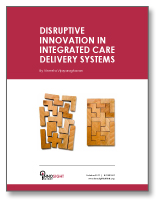Foreword by Jason Hwang
What defines a high-performing health system? Over the years, with the recognition that health care spending was on an unsustainable trajectory, the definition has increasingly shifted to incorporate value and affordability as essential qualities of our top health care institutions.
More recently, as we tracked the debate surrounding the Patient Protection and Affordable Care Act and followed discussions about how to implement accountable care organizations, we took note of a growing phenomenon—that many of the organizations suggested as models for the rest of the nation’s health care fell into the category we had previously described as “integrated, fixed-fee providers.” These health systems combined the functions of both payor and provider, and we postulated their realigned incentives would lead them to introduce disruptive, high-value models of health care that non-integrated systems simply could not.
Yet the picture was not so clear-cut. While it was true that a handful of integrated health systems were decisively outpacing their peers across nearly all quality and cost measures, attempts to expand or replicate them in new markets had often failed. Furthermore, even within the category of integrated health systems, the range of performance varied widely, with some lagging far behind despite possessing what seemed to be the key ingredients for success.
There are a variety of explanations for why only some integrated systems have risen to the top—many of them unsatisfying, seemingly incomplete, or sometimes even contradictory. Is it culture? The history or leadership of the organization? The unique community it serves? The size of the health system? Identifying the “secret sauce” that under-pins the success of these few health systems is essential to ensuring that similar organizations can be cultivated elsewhere and that one day every American will be able to access high quality, affordable care.
This case study series attempted to do exactly that. We employed a case-based investigation to uncover how integrated systems appear to think, act, and innovate differently. Seven health systems were selected to represent different points across the spectrum of integration, while also reflecting the diverse characteristics of this category of health systems.
In the end, we found very different histories and pathways to integration, unique cultures and missions, and divergent organization sizes and communities. Yet we also discovered a multitude of innovations that shared a similar underlying rationale, which led very different health systems down a common path. In several instances, we found the unexpected, both encouraging and disappointing. Thus, you will find this summary paper organized into three sections: 1) What we expected to find, 2) What we found but did not expect, and 3) What we expected but did not find.
Our major observations and findings include:
• Documenting best practices in the use of electronic health records and health IT that should be implemented across all health systems as stimulus funds promote their
widespread adoption
• Validating the importance of expanding the scopes of practice of various clinical staff, including nurse practitioners and physician assistants, to ensure access to quality care through disruptive delivery models
• Detailing the patient experience within these integrated care delivery systems, where patients typically received more care—not less—in contrast to the managed care organizations of the 1990s
• Highlighting and assessing the relative success of innovations already underway at multiple integrated systems, which may be incorporated into today’s ongoing integration efforts, including mergers, accountable care
organizations, and virtual assemblages being formed to participate in bundled payment programs and pay-for-performance contracts
In summary, readers will discover that many elements of our future health care system are already in place, scattered across the country, but catalogued and documented here through face-to-face conversations with those directly responsible for those innovations.
This paper is the culmination of nearly two years of work in partnership with the Pioneer Portfolio and our eminent case study subjects, and though it contains some of our most important conclusions, it cannot replace the depth of information embedded in the seven case studies. I encourage you to read each of them to gain a more complete picture of what it takes to be a high-performing health system in the 21st century.
________________________________________
About the case study series
Disruptive innovations in health care have the potential to decrease costs while improving both the quality and accessibility of care. This paper is part of a series of case studies that uses disruptive innovation theory to examine integrated delivery systems and aims to identify the critical factors necessary to achieve many of the desired quality, cost, and access improvements called for in current reform proposals. By providing a historical and strategic analysis of integrated fixed-fee providers, this project hopes to accelerate the adoption of disruptive innovations throughout the health care delivery system.
Acknowledgments
Funding for this case study series was provided by a grant from the Robert Wood Johnson Foundation’s Pioneer Portfolio, which supports innovative ideas that may lead to significant breakthroughs in the future of health care. The authors also thank the participating health systems and interview subjects for their cooperation and assistance.



